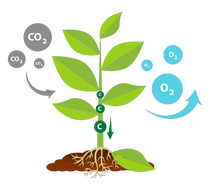Agriculture
Carbon Farming: Agriculture’s Role in Climate Solutions
What if every one of the millions of farmers around the world adopted practices that could mitigate climate change? Find out how carbon farming can make agriculture part of the solution to climate change.

What is Carbon Farming?
Carbon farming is a set of sustainable agricultural practices aimed at reducing greenhouse gas (GHG) emissions and sequestering carbon in soil and vegetation. It involves practices such as minimizing tillage, using cover crops, and reducing fertilizer use. Each of these practices can help increase soil health, improve crop yields, and promote sustainable land use practices while reducing the carbon footprint of agriculture. Carbon markets are emerging that allow farmers to earn additional revenue from implementing these carbon farming practices.
Plants such as crops like wheat and cotton, absorb carbon dioxide (CO2) from the atmosphere during photosynthesis. Carbon (C) is stored in their tissues and oxygen (O2) is created. The capacity to store or sequester carbon is why plants are called "carbon sinks".
.jpg)
How can Carbon Farming help farmers, society, and the planet?
Farmers, society, and the planet can all benefit from carbon farming in various ways as carbon farming contributes to global efforts to mitigate climate change.
Carbon farming practices can help farmers improve soil health, increase water retention, and enhance nutrient cycling. This can lead to higher crop yields, reduced reliance on synthetic fertilizers, and improved profitability for farmers. Additionally, by participating in carbon markets and generating carbon credits, farmers can create additional revenue and diversify their income.
Greenhouse gas emissions and the associated impact on the climate are serious threats to the environment and society’s needs. Therefore, mitigating GHG emissions benefits both society and the environment. Carbon sequestered in soil and vegetation through agriculture helps to remove carbon dioxide from the atmosphere, acting as a natural carbon sink. Reducing carbon emissions from agriculture and sequestering carbon through farming helps to reduce the overall carbon footprint of food production and supports society’s efforts to limit global warming.

How does BASF support Carbon Farming?
Across its strategic crops such as wheat, soy, rice, canola, and corn, BASF commits to help farmers achieve a 30% reduction in CO2e emissions per ton of crop produced by 2030.
In 2020, BASF launched its Global Carbon Farming Program, which is designed to enable farmers to reduce on-farm emissions and sequester more carbon into the soil. This can lead to the generation of carbon credits from internationally recognized certifiers. BASF’s program provides farmers with a holistic portfolio of solutions, including seeds, traits, crop protection products, digital farming, and nitrogen-use efficiency products designed to promote sustainable agricultural practices and decarbonize agricultural value chains.
Who else is talking about Carbon Farming?
Carbon farming is widely discussed in the agricultural and environmental sectors. Governments, environmental organizations, and private companies recognize the importance of carbon farming in achieving climate goals and promoting sustainable agriculture.
The FAO highlights that agriculture is responsible for approximately 17% of global greenhouse gas emissions (Source: FAO). Additionally, the European Commission emphasizes the significance of maintaining and enhancing carbon in agricultural soils for sustainable crop production and climate change adaptation (Source: European Commission).
Many private companies in the agricultural sector are actively promoting carbon farming through initiatives like BASF’s Global Carbon Farming Program that aim to protect yield, natural resources, and the environment while providing farmers with an additional source of revenue. SBTi is an initiative that drives ambitious climate action in the private sector by enabling organizations to set science-based emissions reduction targets in order to align with the goals of the Paris Agreement on climate change. SBTi is a partnership between CDP, the United Nations Global Compact, World Resources Institute (WRI) and the World Wide Fund for Nature (WWF). SBTi uses a rigorous and transparent process to ensure that companies' targets are science-based and aligned with the latest climate science.
Overall, carbon farming is gaining traction as a catalyst for sustainable agriculture and climate change mitigation, with various stakeholders recognizing its potential benefits and actively engaging in related discussions and initiatives.
Last Update February 15, 2024


